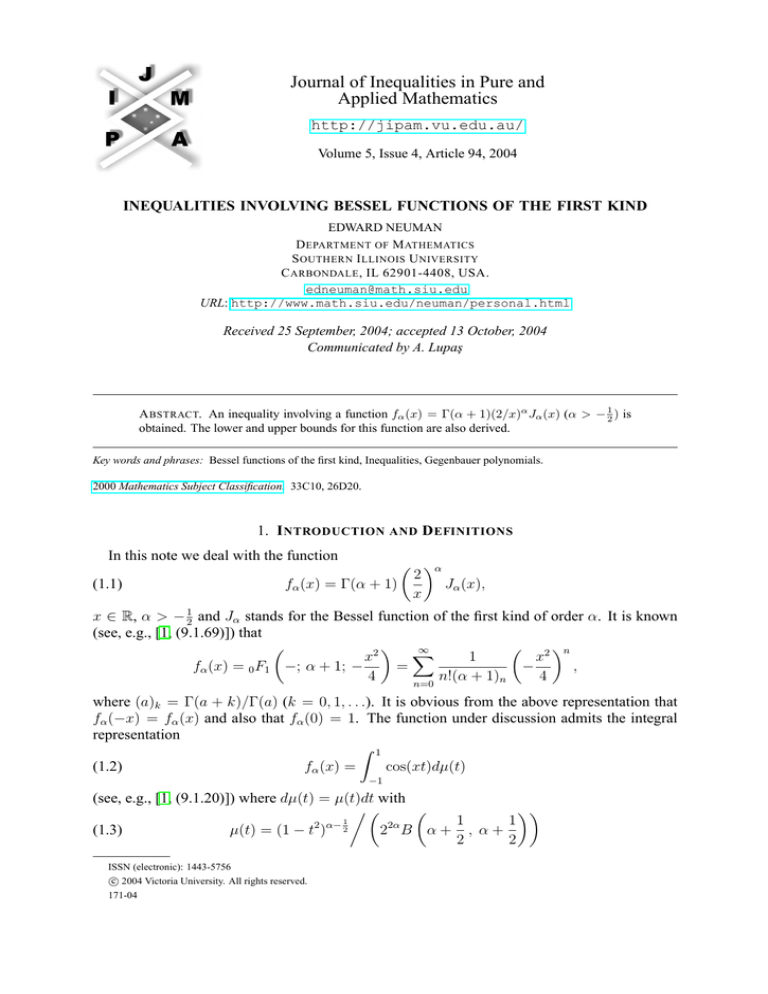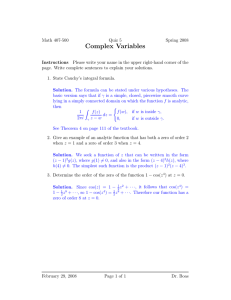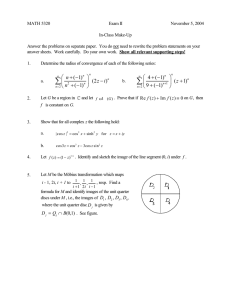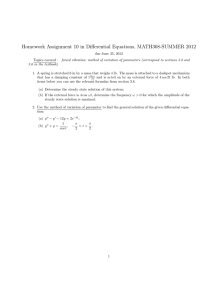
Journal of Inequalities in Pure and
Applied Mathematics
http://jipam.vu.edu.au/
Volume 5, Issue 4, Article 94, 2004
INEQUALITIES INVOLVING BESSEL FUNCTIONS OF THE FIRST KIND
EDWARD NEUMAN
D EPARTMENT OF M ATHEMATICS
S OUTHERN I LLINOIS U NIVERSITY
C ARBONDALE , IL 62901-4408, USA.
edneuman@math.siu.edu
URL: http://www.math.siu.edu/neuman/personal.html
Received 25 September, 2004; accepted 13 October, 2004
Communicated by A. Lupaş
A BSTRACT. An inequality involving a function fα (x) = Γ(α + 1)(2/x)α Jα (x) (α > − 21 ) is
obtained. The lower and upper bounds for this function are also derived.
Key words and phrases: Bessel functions of the first kind, Inequalities, Gegenbauer polynomials.
2000 Mathematics Subject Classification. 33C10, 26D20.
1. I NTRODUCTION AND D EFINITIONS
In this note we deal with the function
(1.1)
α
2
fα (x) = Γ(α + 1)
Jα (x),
x
x ∈ R, α > − 21 and Jα stands for the Bessel function of the first kind of order α. It is known
(see, e.g., [1, (9.1.69)]) that
X
2 n
∞
x2
1
x
=
−
,
fα (x) = 0 F1 −; α + 1; −
4
n!(α + 1)n
4
n=0
where (a)k = Γ(a + k)/Γ(a) (k = 0, 1, . . .). It is obvious from the above representation that
fα (−x) = fα (x) and also that fα (0) = 1. The function under discussion admits the integral
representation
Z 1
(1.2)
fα (x) =
cos(xt)dµ(t)
−1
(see, e.g., [1, (9.1.20)]) where dµ(t) = µ(t)dt with
1
1
2 α− 12
2α
(1.3)
µ(t) = (1 − t )
2 B α+ , α+
2
2
ISSN (electronic): 1443-5756
c 2004 Victoria University. All rights reserved.
171-04
2
E DWARD N EUMAN
being the Dirichlet measure on the interval [−1, 1] and B(·, ·) stands for the beta function.
Clearly
Z 1
(1.4)
dµ(t) = 1.
−1
Thus µ(t) is the probability measure on the interval [−1, 1].
In [2], R. Askey has shown that the following inequality
fα (x) + fα (y) ≤ 1 + fα (z)
(1.5)
holds true for all α ≥ 0 and z 2 = x2 + y 2 . This provides a generalization of Grünbaum’s
inequality ([4]) who has established (1.5) for α = 0.
In this note we give a different upper bound for the sum fα (x) + fα (y) (see (2.1)). Also,
lower and upper bounds for the function in question are derived.
2. M AIN R ESULTS
Our first result reads as follows.
Theorem 2.1. Let x, y ∈ R. If α > − 12 , then
(2.1)
[fα (x) + fα (y)]2 ≤ [1 + fα (x + y)][1 + fα (x − y)].
Proof. Using (1.2), some elementary trigonometric identities, Cauchy-Schwarz inequality for
integrals, and (1.4) we obtain
Z 1
|fα (x) + fα (y)| ≤
| cos(xt) + cos(yt)|dµ(t)
−1
Z 1
(x
+
y)t
(x
−
y)t
cos
dµ(t)
=2
cos
2
2
−1
Z 1
12 Z 1
12
2 (x + y)t
2 (x − y)t
≤2
cos
dµ(t)
cos
dµ(t)
2
2
−1
−1
Z 1
12
1
=2
(1 + cos(x + y)t)dµ(t)
2 −1
Z 1
12
1
×
(1 + cos(x − y)t)dµ(t)
2 −1
1
1
= [1 + fα (x + y)] 2 [1 + fα (x − y)] 2 .
Hence, the assertion follows.
When x = y, inequality (2.1) simplifies to 2fα2 (x) ≤ 1 + fα (2x) which bears resemblance of
the double-angle formula for the cosine function 2 cos2 x = 1 + cos 2x.
Our next goal is to establish computable lower and upper bounds for the function fα . We
recall some well-known facts about Gegenbauer polynomials Ckα (α > − 21 , k ∈ N) and the
Gauss-Gegenbauer quadrature formulas. They are orthogonal on the interval [−1, 1] with the
1
weight function w(t) = (1 − t2 )α− 2 . The explicit formula for Ckα is
[k/2]
Ckα (t)
=
X
m=0
J. Inequal. Pure and Appl. Math., 5(4) Art. 94, 2004
(−1)m
Γ(α + k − m)
(2t)k−2m
Γ(α)m!(k − 2m)!
http://jipam.vu.edu.au/
I NEQUALITIES I NVOLVING B ESSEL F UNCTIONS OF THE F IRST K IND
3
(see, e.g., [1, (22.3.4)]). In particular,
2
C3α (t) = α(α + 1)[2(α + 2)t3 − 3t].
3
The classical Gauss-Gegenbauer quadrature formula with the remainder is [3]
Z 1
k
X
2 α− 21
(2.3)
(1 − t )
g(t)dt =
wi g(ti ) + γk g (2k) (η),
(2.2)
C2α (t) = 2α(α + 1)t2 − α,
−1
i=1
2k
where g ∈ C ([−1, 1]), γk is a positive number and does not depend on g, and η is an intermediate point in the interval (−1, 1). Recall that the nodes ti (1 ≤ i ≤ n) are the roots of Ckα and
the weights wi are given explicitly by [5, (15.3.2)]
wi = π 22−2α
(2.4)
Γ(2α + k)
1
·
2
2
k![Γ(α)]
(1 − ti )[(Ckα )0 (ti )]2
(1 ≤ i ≤ k).
We are in a position to prove the following.
Theorem 2.2. Let α > − 12 . If |x| ≤ π2 , then
!
x
cos p
(2.5)
≤ fα (x)
2(α + 1)
s
"
!#
1
3
≤
2α + 1 + (α + 2) cos
x
.
2(α + 2)
3(α + 1)
Equalities hold in (2.5) if x = 0.
Proof. In order to establish the lower bound in (2.5) we use the Gauss-Gegenbauer quadrature
formula (2.3) with g(t) = cos(xt) and k = 2. Since g (4) (t) = x4 cos(xt) ≥ 0 for t ∈ [−1, 1]
and |x| ≤ π2 ,
Z 1
1
(2.6)
w1 g(t1 ) + w2 g(t2 ) ≤
(1 − t2 )α− 2 cos(xt)dt.
−1
Making use of (2.2) and (2.4) we obtain
1
−t1 = t2 = p
2(α + 1)
1
2
2α
1
,
2
and w1 = w2 = 2 B(α +
1
2α
2 B α+ , α+
2
1
).
2
α+
This in conjunction with (2.6) gives
! Z
1
1
1
x
≤
cos p
(1 − t2 )α− 2 cos(xt)dt.
2
2(α + 1)
−1
Application of (1.3) together with the use of (1.2) gives the asserted result. In order to derive
the upper bound in (2.5) we use again (2.3). Letting g(t) = cos(xt) and k = 3 one has
g (6) (t) = −x6 cos(xt) ≤ 0 for |t| ≤ 1 and |x| ≤ π2 . Hence
Z 1
1
(2.7)
(1 − t2 )α− 2 cos(xt)dt ≤ w1 g(t1 ) + w2 g(t2 ) + w3 g(t3 ).
−1
It follows from (2.2) and (2.4) that
s
−t1 = t3 =
J. Inequal. Pure and Appl. Math., 5(4) Art. 94, 2004
3
,
2(α + 2)
t2 = 0
http://jipam.vu.edu.au/
4
E DWARD N EUMAN
and
1
1
α+2
w1 = w3 = 2 B α + , α +
,
2
2 6(α + 1)
1
1 2α + 1
2α
w2 = 2 B α + , α +
.
2
2 3(α + 1)
This in conjunction with (2.7), (1.3), and (1.2) gives the desired result. The proof is complete.
2α
Sharper lower and upper bounds for fα can be obtained using higher order quadrature formulas (2.3) with even and odd numbers of knots, respectively.
R EFERENCES
[1] M. ABRAMOWITZ AND I.A. STEGUN (Eds.), Handbook of Mathematical Functions with Formulas, Graphs, and Mathematical Tables, Dover Publications, Inc., New York, 1965.
[2] R. ASKEY, Grünbaum’s inequality for Bessel functions, J. Math. Anal. Appl., 41 (1973), 122–124.
[3] K.E. ATKINSON, An Introduction to Numerical Analysis, 2nd ed., Wiley, New York, 1989.
[4] F. GRÜNBAUM, A property of Legendre polynomials, Proc. Nat. Acad. Sci., USA, 67 (1970), 959–
960.
[5] G. SZEGÖ, Orthogonal polynomials, in Colloquium Publications, Vol. 23, 4th ed., American Mathematical Society, Providence, RI, 1975.
J. Inequal. Pure and Appl. Math., 5(4) Art. 94, 2004
http://jipam.vu.edu.au/






